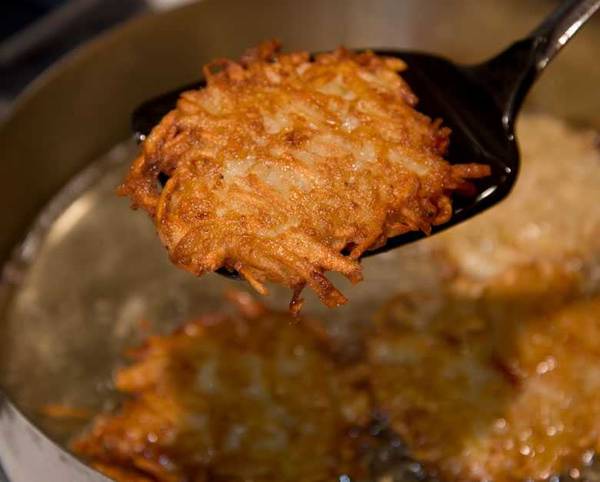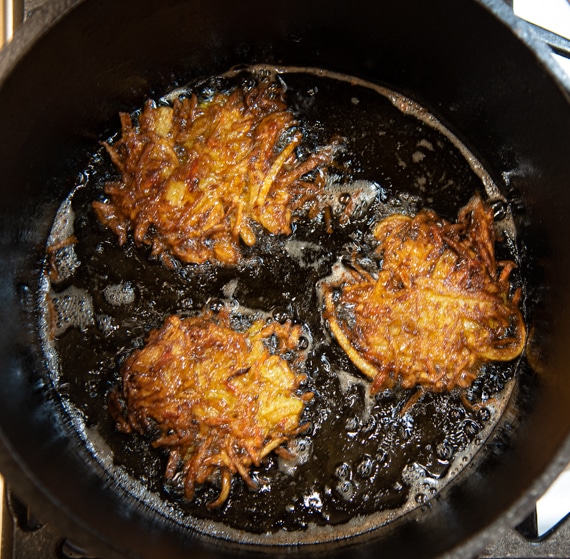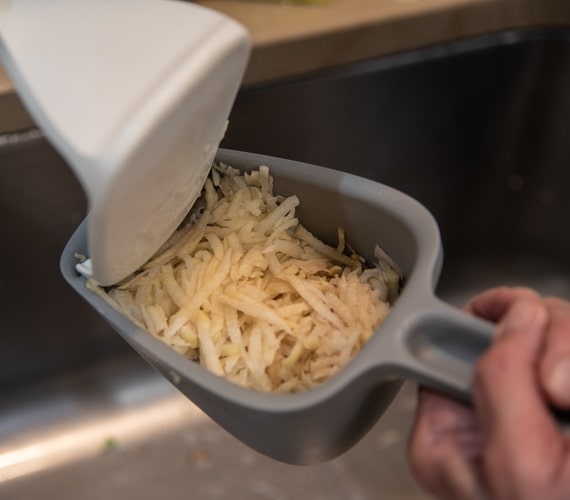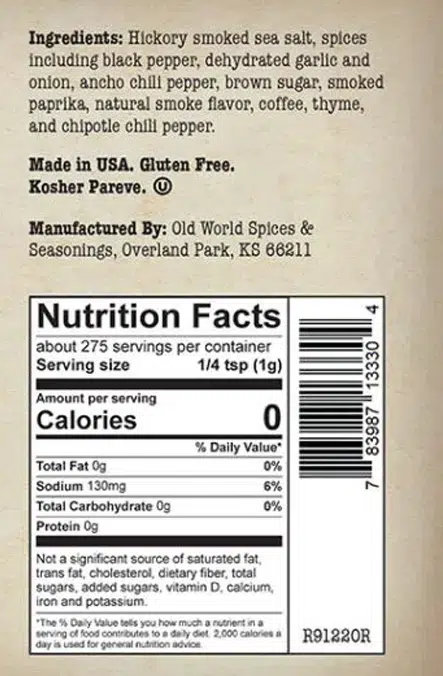Here’s a hash browns recipe that you’re going to latke a lot!
When it comes to how to make hash browns, the best recipes come from Jewish households, where potato pancakes, called latkes, have been traditionally fried every December for the holiday of Hanukkah for centuries. December is also when potatoes, onions, and olive oil are fresh.
Hanukkah celebrates the expulsion from Jerusalem of Syrian-Greek occupiers by freedom fighters called Maccabees in 168 BC. Legend has it that when the main temple was recaptured, there was only enough olive oil to keep the holy lamp burning for one day. But that small amount of oil kept the lamp alive for the eight days it took to harvest, press, and purify more oil: a miracle. Hanukkah became the eight day holiday to commemorate the miracle of the oil, when Jews eat foods fried in olive oil and exchange gifts. Fried chicken, latkes, and a sort of doughnut are also traditional.
Latkes for a crowd
Here’s how restaurants make lots of latkes at once:
1) Put a large rimmed baking pan into the oven and pour in about 1/4 inch (6.4 mm) of oil. Preheat to 450°F (232.2°C) for about 20 minutes.
2) Slip the latkes into the hot oil and paint the tops of the latkes with a bit of the hot oil.
3) Bake/fry them for 6-8 minutes on one side until GBD, turn, and bake for another 5 minutes or so. Add oil as needed, but wait until it heats up before cooking.
Innovations?
Latke competitions are not as widespread as barbecue cookoffs, but they seem to be growing in popularity. Since I am addicted to potato pancakes, I read every latke recipe I see. Here are some of the innovations I have read about that you may wish to try:
- For extra crispiness, use egg whites only or add corn starch.
- Partially boil the potatoes for about 10 minutes, let them dry and cool before grating.
- Use bread crumbs or matzoh meal instead of flour in the mix.
- Coat the patties with bread crumbs, matzoh meal, or panko.
Upscale latkes?
Latkes, originally peasant food, have been going upscale lately, appearing on the menus of white table cloth restaurants. Chefs now make them with everything from sweet potato (yum), zucchini, carrot, apples, pears, cauliflower, mushrooms, lentils, celery root, rice, cabbage, parsnips, olives, and even beets (yuk). I have even seen these ingredients added to potato latkes.
I have also heard of adding fresh herbs such as chives, thyme, parsley, or rosemary, ginger, and even parmesan cheese.
For garnishes, the shee shee crowd uses creme fraiche and caviar, smoked salmon and whipped cream cheese, sour cream with chives and salmon eggs, Greek yogurt with fresh figs, and watercress sprinkled on everything. While you’re at it, why not put a sunnyside up egg or eggs benedict on top?
If you’re not Jewish and you really want to cross the streams, fry them in bacon or duck fat, and put chopped bacon in the blend. If you are Jewish and you even think about this, well the punishment is worse than growing hair on your palms…
Oy vey!
In other cultures
Potato pancakes are a treat in many cultures. The basic recipe is pretty much the same around the world, but there are some fun variations.
Hash browns are a staple in diners across the US and in some fast food restaurants. Cooked on a griddle, often they are odd shaped or served in loose chunks. In fast food restaurants they are molded into patties and deep fried.
Boxty are big in Ireland where the ditty goes “Boxty on the griddle, boxty on the pan, If you can’t bake boxty, Sure you’ll never get a man.”
Rästis in Switzerland are the diameter of whatever pan they are cooked in and can even be frisbee sized. Cheese, bacon, and apple are often mixed in. The trick is in flipping them.
Reibekuchen or Kartoffel Plätzchen or Kartoffelpuffer is what they are called in Germany and they are usually served with apple sauce. Däppekuchen is another German delicacy, especially in the Rheinland, of grated potatoes, eggs, and ham or sausage, piled deep into a casserole, topped with bacon, and baked.
Placki Ziemniaczane is what they are called in Poland.
Raggmunk are served with bacon and jam in Sweden.
Gamjajeon are the Korean version, often made with hot peppers.
Draniki is what you ask for in Russia.
Aloo tikki are mashed potato patties in India, often with herbs and spices, especially coriander.
And then there are Tater Tots…
Makes:
About 8 latkesTakes:
Equipment
- Dutch oven or deep frying pan
Ingredients
- 1 whole egg
- 2 tablespoons all-purpose flour
- ¼ teaspoon Morton Coarse Kosher Salt
- ¼ teaspoon fresh ground black pepper
- ½ teaspoon baking soda
- 1 pound starchy potatoes such as russets (about 2 large)
- ½ cup onion or shallots (about 1 medium onion)
- 1 cup olive oil approximately
These recipes were created in US Customary measurements and the conversion to metric is being done by calculations. They should be accurate, but it is possible there could be an error. If you find one, please let us know in the comments at the bottom of the page
Method
- Preheat. Preheat the oven to 300°F (148.9°C). Take a sheet pan, put a rack over it, and put it in the oven. This is used for draining and crisping the pancakes and keeping them hot when they come out of the oil.
- Prep the binder. Crack the egg into a large mixing bowl, and beat it lightly with a fork or whisk. Add the flour, baking soda, salt, and pepper and stir together with the fork. Don’t worry if there are lumps.
- Tater time. Peel the potatoes. Now shred them with the big holes on a box grater or a food processor so they are all uniform in size. Mix in the onions. This next step is crucial. We are now going to try to get as much moisture as possible out of the potatoes and onions. Nothing works better than squeezing the shreds in a potato ricer. Don't worry, it won't push them through the holes. If you don't have a ricer but you have a salad spinner, take the taters for a ride. If not, with your hands, pick up a small amount of the grated potato/onion mix and, over the sink, squeeze out as much water as possible. Repeat. Then spread the grated potato mix out on a double layer of paper towels, cover with another double layer of paper towels, and press hard. Another method is to put the mix into the center of a few layers of cheesecloth, a clean T-shirt, or a clean kitchen towel, pull together the edges making a pouch, and twist and squeeze out as much moisture as possible. Add the potato mix to the bowl with the egg mixture, and stir gently until the potatoes are all coated.
- Fry. Pour enough oil into the pot to cover the bottom about ¼ inch deep. You don't want to totally submerge the patties so steam can escape the side above the surface. More importantly, you want the potatoes in contact with the bottom because hot metal conducts more heat that hot oil. Heat the oil to about 375°F (190.6°C). Get it all the way up there because the cold potatoes will cool it off quickly.
- Patty time. One at a time, make patties about 3 inches (76.2 mm) across and about 1/2 inch (12.7 mm) high, but leave the edges jagged. An ice cream scoop is a good measuring device. Ease the patties into the oil one at a time about a minute apart, being careful not to splash. You should be able to fit four into a 12 inch (304.8 mm) pot at a time, and they should not be touching much. The reason to stagger their start time is to keep the oil temperature hot. If you add four at a time, the oil temp will drop and the pancakes can get soggy. When you add the last one, you should notice the edges of the first one are getting golden after 5 to 7 minutes. Check the bottom of the first patty by lifting it with a slotted spatula. It should be golden, but there still may be milky parts showing. Flip it, and it is easiest with two spatulas or a spatula and a large spoon so they don't splatter or break. Flip the patties away from you so they don't splash. Cook another 3 to 4 minutes on the second side until golden. Remove the patty and gently put it on the rack over the baking pan in the oven to crisp even more and to make sure the center is cooked through.
- Treats! When they are all done, scoop out the bits that are left behind in the oil, drain, cool, and eat them yourself. Cook's treat!
- Serve. After they have been in the oven for about 15 minutes the latkes will darken a bit, crisp even more on the outsides, and cook thoroughly through the center. Sprinkle lightly with large grain salt and serve hot. L'chiam!









High quality websites are expensive to run. If you help us, we’ll pay you back bigtime with an ad-free experience and a lot of freebies!
Millions come to AmazingRibs.com every month for high quality tested recipes, tips on technique, science, mythbusting, product reviews, and inspiration. But it is expensive to run a website with more than 2,000 pages and we don’t have a big corporate partner to subsidize us.
Our most important source of sustenance is people who join our Pitmaster Club. But please don’t think of it as a donation. Members get MANY great benefits. We block all third-party ads, we give members free ebooks, magazines, interviews, webinars, more recipes, a monthly sweepstakes with prizes worth up to $2,000, discounts on products, and best of all a community of like-minded cooks free of flame wars. Click below to see all the benefits, take a free 30 day trial, and help keep this site alive.
Post comments and questions below
1) Please try the search box at the top of every page before you ask for help.
2) Try to post your question to the appropriate page.
3) Tell us everything we need to know to help such as the type of cooker and thermometer. Dial thermometers are often off by as much as 50°F so if you are not using a good digital thermometer we probably can’t help you with time and temp questions. Please read this article about thermometers.
4) If you are a member of the Pitmaster Club, your comments login is probably different.
5) Posts with links in them may not appear immediately.
Moderators